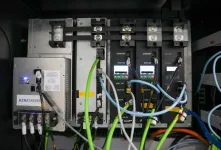(Press-News.org) WASHINGTON — As the global threat of H5N1 influenza looms with outbreaks across species and continents including the U.S., three international vaccine and public health experts say it is time to fully resource and support a robust strategy to address this and future potential pandemic influenza threats, including to consider voluntary vaccination for those now at exposure risk.
“At this critical juncture, decisions about vaccine development, stockpiling, and deployment will shape our ability to respond to immediate and future pandemic risks,” write Jesse Goodman, MD, PhD; Rick A. Bright, PhD; and Nicole Lurie, MD, MSPH, in a JAMA Viewpoint published Sept. 4.
The current outbreak of H5N1 in North America has infected poultry, cows, wild birds, and marine and terrestrial mammals, along with at least 13 humans, primarily on dairy and poultry farms. No human-to-human transmission has been reported.
“It is highly concerning that this H5N1 strain, compared with prior ones, has had unprecedented spread among mammals” says Goodman. “Although human cases have so far been relatively mild, the threat of a pandemic is real, given the virus’s widespread and continued presence close to humans and its potential to reassort with human influenza viruses or mutate to acquire the ability to transmit among humans.”
Goodman is a professor of medicine at Georgetown University School of Medicine and former FDA Chief Scientist; Bright is a principal with Bright Global Health and former Deputy Assistant Secretary for Preparedness and Response and the Director of the Biomedical Advanced Research and Development Authority (BARDA); and Lurie is executive director for Preparedness and Response at the Coalition for Epidemic Preparedness Innovations and Director of CEPI-US and former Assistant Secretary for Preparedness and Response at the U.S. Department of Health and Human Services.
Focusing on vaccines, Goodman and his colleagues outline short, medium and long-term actions to combat the H5N1 risk: protect exposed individuals and reduce pandemic risk; refresh vaccine stockpiles and enhance capacity; lay the groundwork for mitigating future threats.
Short term
The authors note that the U.S. government is readying 4.8 million doses of stockpiled H5N8 vaccine, which is expected to offer cross-protection against current H5N1 strains.
As a short term consideration, the writers say, “Provided adequate supporting data and regulatory review, stockpiled vaccine(s) should be offered voluntarily to individuals at exposure risk.” Those at risk include farm workers with closure contact to animals.
Medium term
In the medium term, the authors stress the importance of ensuring that vaccine stockpiles are refreshed with doses well matched to circulating viruses. The goal is to ensure that at least 20 million individuals, particularly critical workforce members, can be rapidly immunized in the event of a pandemic.
In addition, the public health trio call for taking steps now to ready and enhance global pandemic influenza vaccine development and production capacity, including evaluating the potential of mRNA vaccines, which offer faster and more scalable manufacturing processes.
Long term
Looking further ahead, Goodman and his colleagues advocate for the exploration of pre-pandemic immunization strategies. This could involve vaccinating high-risk groups during interpandemic periods to build population immunity against potential pandemic strains, a strategy that, while unproven, could significantly mitigate the impact of future pandemics.
Finally, the authors call on elected officials, governments, global partners and the private sector to address H5N1 and other pandemic influenza threats through a comprehensive strategy for human and animal health encompassing pandemic vaccines as well as diagnostics, therapies, and non-pharmaceutical interventions. They note that the convergence of health and agricultural concerns, including protecting workers, farm animals, and the economy, presents an opportunity to transcend divides.
They conclude, “The time for decisive action is not when a pandemic strikes, but today, while we have the opportunity.”
###
END
Resting brain stem cells hardly differ from normal astrocytes, which support the nerve cells in the brain. How can almost identical cells perform such different functions? The key lies in the methylation of their genetic material, which endowes these special astrocytes with stem cell properties. Scientists from the German Cancer Research Center (DKFZ) and Heidelberg University have published their findings in the journal Nature. In mice, the researchers showed that experimentally induced lack of blood ...
Researchers have uncovered how hormones profoundly affect our immune systems, explaining why men and women are affected by diseases differently.
Scientists from the Karolinska Institutet in Sweden and Imperial College London have shown for the first time which aspects of our immune systems are regulated by sex hormones, and the impacts this has on disease risk and health outcomes in males and females.
It is well established that diseases can affect men and women differently, due to subtle differences ...
Why do some people feel itchy after a mosquito bite or exposure to an allergen like dust or pollen, while others do not? A new study has pinpointed the reason for these differences, finding the pathway by which immune and nerve cells interact and lead to itching. The researchers, led by allergy and immunology specialists at Massachusetts General Hospital, a founding member of the Mass General Brigham healthcare system, then blocked this pathway in preclinical studies, suggesting a new treatment approach for allergies. The findings are published in Nature.
“Our research provides ...
By repeatedly scanning the brains of a small group of patients for a year and a half, Weill Cornell Medicine researchers have identified a distinct pattern of neuronal interactions that appears to predispose some people to developing depression.
Published Sept. 4 in Nature, the work highlights the potential of a new “deep scanning” approach to help predict a person’s susceptibility to depression and other neuropsychiatric conditions and may guide the development of novel treatments.
Neuroscientists have long relied on functional magnetic resonance imaging (fMRI) to identify patterns of activity ...
Exercise intolerance is often severe among patients with cardiovascular disease and can impose significant limitations on their physical abilities and quality of life. Medications known as cardiac myosin inhibitors (CMIs) are being developed to help patients with hypertrophic obstructive cardiomyopathy (HOCM), a disease in which the heart muscle becomes thickened leading to reduced blood flow out of the heart. In a new analysis led by researchers from Mass General Brigham, investigators probed multiple exercise response ...
Leuven/Amsterdam/Cambridge, 5 September– A team of researchers at the VIB-KU Leuven Center for Cancer Biology, the Netherlands Cancer Institute and Oncode Institute and the University of Cambridge have discovered that a defensive mechanism connected to the menstrual cycle plays a role in spreading mutant cells within mammary tissue. A new study published in Nature describes how the growth and subsequent removal of extra milk ducts in breast tissue during the menstrual cycle can contribute to the spread of mutant cells leading to large mutant fields prone to develop tumors.
Although tissue in healthy individuals may look completely normal, ...
New research shows how oceans can be used to help address major challenges such as the shortage of antimicrobial medicines, solutions for plastic pollution and novel enzymes for genome editing.
In the past 20 years, scientists have greatly increased the number of microbial genomes they have collected from the ocean. However, using this information for biotechnology and medicine has been difficult.
For this new study, led by BGI Research in China in collaboration with the Shandong University, Xiamen University, ...
Investigators involved in a multicenter study co-led by Cedars-Sinai discovered a pathway by which immune cells prevent the lungs’ protective barrier from healing after viral infections like COVID-19. The findings, published in Nature may lead to new therapeutic treatment options.
The COVID-19 pandemic revealed how viral infections can cause long-lasting effects—a condition called long COVID. Also known as post-acute sequelae of SARS-CoV-2, long COVID has left a devastating trail of people who continue to live with ...
Korea Electrotechnology Research Institute (KERI) has succeeded in domestically developing the ‘CNC driving system’ technology, a core component of machine tools—often referred to as "Mother Machines," the machines that make other machines.
The CNC (Computer Numerical Control) system is an electronic module that processes numerical information via a computer and automatically controls all functions of machine tools, including position, speed, and rotation of a machine tool. In a computer, it plays a role similar to that of a CPU.
A major challenge ...
Digital Science today announces the launch of Papers Pro, an AI-enhanced premium version of its acclaimed reference manager, Papers.
As part of the ReadCube suite of literature solutions, Papers Pro is designed to make researchers and students more productive in their daily tasks by integrating cutting-edge AI tools to transform how they discover, organize, read, annotate, share and cite research materials.
Search and discovery has always been a core part of the Papers workflow. The launch of Papers Pro introduces new search capabilities, powered by Dimensions, one of the world’s largest ...

